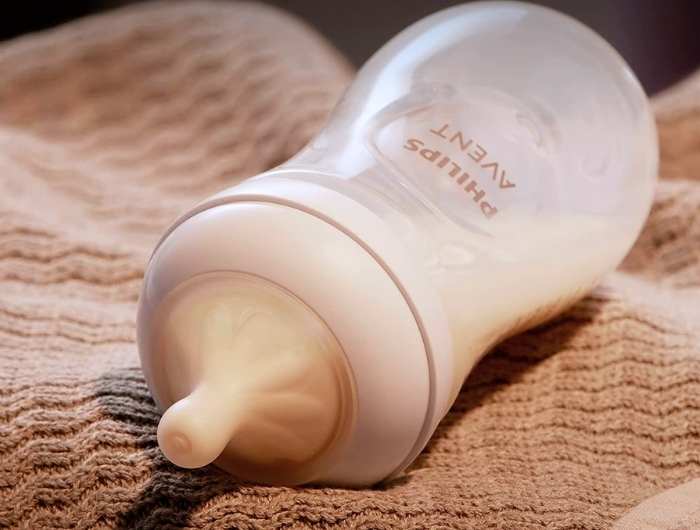Switching formulas can be a tricky process that requires some planning and patience.
Why Switch Formula?
There are many reasons switching formula brands might be necessary for your baby. Some of the most common ones are:
Your baby has a milk allergy or intolerance
Formula feeding has its advantages but some babies are allergic or sensitive to the proteins in cow's milk, which is the main ingredient in most baby formulas. This can cause symptoms like rashes, vomiting, diarrhea, gas, or colic.
If your baby has a milk allergy or intolerance, your doctor might suggest switching to a soy formula or a hypoallergenic formula that has broken down proteins that are easier to digest.
Your baby has reflux or is spitting up
Some babies spit up more than others, which can be normal and harmless. But if your baby spits up a lot or seems uncomfortable or fussy after feeding, it could be a sign of reflux.
Reflux is when the stomach contents come back up into the esophagus, causing irritation and pain. If your baby has reflux, your doctor might recommend switching to a sensitive baby formula that stays down better.
Your baby is not gaining enough weight or growing well
Some babies need more calories or nutrients than others to grow and thrive. If your baby is not gaining enough weight or growing well, your doctor might suggest switching to a higher-calorie formula or a formula that has added vitamins and minerals.
You want to save money or convenience
Formula can be expensive and hard to find sometimes, especially if you use a specialty formula. You might want to switch to a cheaper or more available formula that still meets your baby's needs. Or switch from a ready-to-feed formula to a powdered baby formula that takes less space and lasts longer.

How to Switch Formula?
Switching formulas is not as simple as just buying a new can and feeding it to your baby. You need to do it gradually and carefully to avoid upsetting your baby's stomach or causing other problems. Here are some steps to follow when switching infant formulas:
Talk to your doctor first
Before you switch formulas, you should always consult with your doctor or pediatrician. They can help you choose the best formula for your baby and advise you on how to switch formula safely. They can also monitor your baby's reaction and growth during the transition.
Start slowly and gradually
Don't switch formulas all at once. Instead, start by mixing a small amount of the new formula with the old one, and gradually increase the ratio over several days or weeks.
For example, you can start by mixing one ounce of the new formula with three ounces of the old one for a few feedings, then increase it to two ounces of each for a few more feedings, then three ounces of the new formula with one ounce of the old one, and so on until you're using only the new formula.
This way, you can help your baby adjust to the taste and digestibility of the new formula without shocking their system.
Watch for signs of intolerance or allergy
As you switch formulas, keep an eye on your baby's behavior and health. Look for signs of intolerance or allergy, such as rashes, vomiting, diarrhea, gas, colic, fussiness, or poor weight gain. If you notice any of these symptoms, stop using the new formula and call your doctor right away. They might suggest trying a different formula or going back to the old one.
Don't switch back and forth too often
Once you find a formula that works well for your baby, stick with it unless there's a good reason to change it. Switching formulas too often can confuse your baby's taste buds and stomach, and make them more prone to rejection or intolerance. If you need to switch formulas again in the future, follow the same steps as before and consult with your doctor.
Switching infant formulas can be challenging for both you and your baby, but it doesn't have to be stressful or scary. With some planning and guidance from your doctor, you can make the transition smoothly and safely.
Remember that every baby is different and what works for one might not work for another. The most important thing is to find a baby's formula brand that meets your baby's needs and makes your baby happy.
Types of Baby Formula
There are different types of baby formulas available, each with its unique advantages and disadvantages.
- Cow’s Milk Formula is the most common type of infant formula, contains proteins, fats, and carbohydrates as well as vitamins and minerals, and formulated to mimic breast milk. Take a look at our guide on how to transition from breast milk to formula.
- Soy Formula is an alternative to cow's milk, ideal for babies with lactose or other milk-related allergies. Another good alternative is goat's milk formula.
- Hypoallergenic Formula, addresses lactose or milk allergies and is less likely to cause digestive issues.
- Powdered Formula, the most economical to buy, with different brands have different nutritional content.
Switching Formulas Within The Same Brand
If you follow the steps above, switching formulas within the same brand should not cause any major issues for your baby. Most brands have similar formulas that differ only in minor ways, such as added iron, DHA, or probiotics. These differences are usually not significant enough to affect your baby's health or well-being.
Switching Formula Brands
However, switching formulas between different brands may be more risky. Different brands may have different sources, amounts and types of ingredients that can affect your baby's digestion and nutrition.
For example, some brands use cow's milk protein, while others use soy protein or hydrolyzed protein. Some brands use corn syrup solids, while others use lactose or sucrose. Some brands use palm oil, while others use coconut oil or sunflower oil.
These differences may not matter for most babies, but they may matter for some babies who have allergies, intolerances or special needs. For example, some babies may be allergic to cow's milk protein or soy protein and need a hypoallergenic formula.
Some babies may have trouble digesting lactose or sucrose and need a low-lactose or lactose-free formula. Some babies may have trouble absorbing fat and need a formula with medium-chain triglycerides (MCT) oil.
Therefore, if you want to switch formulas between different brands, you should be extra careful and consult your pediatrician first. They can help you choose a formula that is compatible with your baby's needs and preferences.
Switching Baby Formula Side Effects
In most cases, it’s fine to change formulas, as long as you stick with the same type, especially if your baby is on a special type of formula. One of the most common side effects of switching formula is fussiness after feedings and changing stool patterns. Your baby may also dislike the new formula’s flavor. It’s not a sign of trouble if your baby’s poop changes in frequency or color.
Some side effects on your baby's health and behavior include:
Changes in stool color and consistency. Iron-fortified formulas can make your baby's poop darker and firmer, while soy-based formulas can make it greenish and looser. These changes are normal and not a cause for concern unless other symptoms accompany them, such as blood, mucus, or a foul smell.
Changes in feeding patterns and appetite. Some formulas may make your baby feel fuller or hungrier than others. These changes are also normal and not a cause for concern unless they affect your baby's weight gain or growth.
Changes in mood and sleep. Some formulas may make your baby more alert or sleepy than others. These changes are also normal and not a cause for concern unless they interfere with your baby's development or well-being.
Digestive Upset. A common side effect of switching baby formula is digestive upset, such as gas or bloating. This is because babies' digestive systems take time to adjust to new formulas' ingredients. Switching to a new baby formula can sometimes cause constipation or diarrhea, as the baby's digestive system adapts to the new formula.
Allergic Reaction. In rare cases, babies may develop an allergic reaction to a new formula. Symptoms can include diarrhea, vomiting, rashes, hives, or difficulty breathing. If you notice any of these symptoms, seek medical attention immediately.
Fussiness or Irritability. Some babies can become more fussy or irritable after switching to a new formula. Still, this is usually temporary, and the baby adjusts within a few days to a week for the new formula.
Conclusion
Switching baby formulas is a common practice among parents who feed their baby formula. However, it is not something that should be done lightly or without proper guidance. Switching baby formulas can have positive or negative effects on your baby's health and well-being, depending on how you do it and what kind of formula you choose.
If you want to switch baby formulas within the same brand, do it gradually and monitor your baby's response. If you want to switch baby formula brands, check with your pediatrician first and choose a reputable brand.
Thank you for reading Mother Bear Reviews, your favorite parenting blog!








